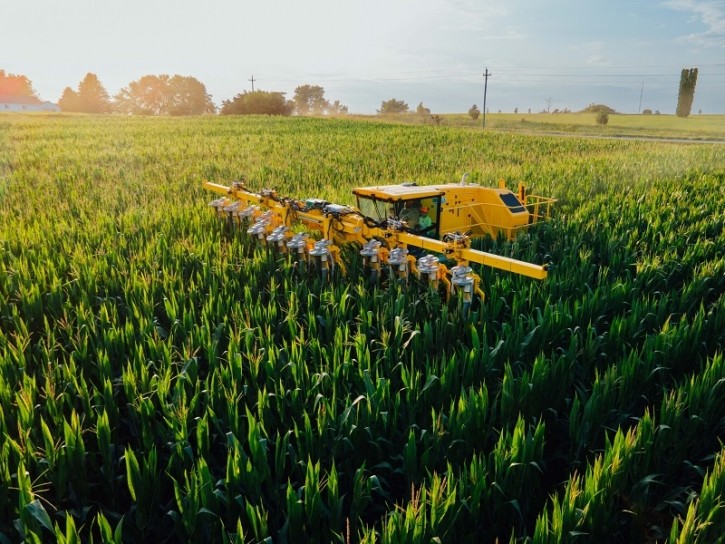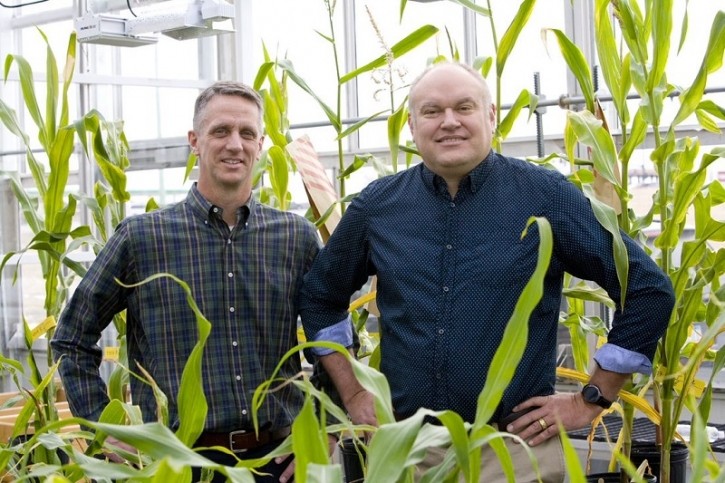On-demand crop pollination: Have the barriers to achieving scale finally been cracked?

The Iowa-headquatered company has fresh wind in its sails thanks to a new €22.5 funding round led by the Vienna-based Liechtenstein Group, known for its investments in sustainable agriculture and innovative technologies.
PowerPollen, founded in 2015, has a unique pollination technology that allows pollen to be collected, preserved, and applied on-demand. This technology promises significantly better pollination and thus higher crop yields, the company claims.
Pollen from wind-pollinated crops such as wheat, rice, corn, rye, barley and oats, usually survives only a few minutes to hours at most. Climate change – drought, excessively high temperatures, pollinator decline, and extreme weather events – has made the pollination of these plants even more complex. PowerPollen's technology offers a solution to these challenges in commodity crops, ensuring more stability and consistency in agricultural yields.
PowerPollen’s patented technology and hardware collects pollen from male plants, and then preserves the viability of the pollen up to four years for future application. Using a custom applicator, the pollen can be applied precisely at the right time and under ideal conditions in the fields. It claims yield improvements of over 20% with corn seeds. What’s more, targeted pollination on demand reduces the need for male plant rows, leading to reduced land use, as well as lower water and resource consumption.
New joint venture leverages on-demand pollination for hybrid rice
In recent years, PowerPollen has proven its technology with Bayer and Corteva for corn, and BASF for wheat. (See how the technology works in corn here.) The new investment will be used to scale the technology for hybrid rice, though a partnership with RiceTec, a Liechtenstein Group portfolio company, expected to be commercial by 2027.
Hybrid rice, first developed in China (where it averted an impending famine) in the 1970s and bred from two very different parent varieties, boasts a 20% or higher yield advantage over conventional pure line varieties and remains a cornerstone of global food security.
Traditional rice cultivation poses escalating environmental and economic risks, including groundwater depletion, methane emissions and labourr challenges, cites PowerPollen. Enabling better hybrid rice pollination systems therefore has the potential to increase the global rice value and sustainable production, it believes.
Like corn and wheat, rice is pollinated by wind. Extreme weather events have made the pollination of these crops even more challenging.
"For years, our technology has proven effective in corn and continues to demonstrate strong potential for applications in other crops. With the new financing, we'll continue to advance our technology, aided by the expertise and global network of the Liechtenstein Group," said Todd Krone, Co-Founder and CEO of PowerPollen.
"We are absolutely convinced of the technology and its importance for more sustainable agriculture and global food security,“ added Johannes Meran, CEO of the Liechtenstein Group. “For RiceTec, our rice seed company, the technology also has enormous potential to further increase the efficiency of this staple food crop for billions of people worldwide," "Through RiceTec genetics and PowerPollen’s technology, we can unlock untapped efficiencies in hybrid rice production, setting the stage for a significant leap forward in global food security and climate change mitigation.”
The company is cryogenically preserving pollen to increase shelf life
Jason Cope, co-founder and chief intellectual property officer, explained the company’s business model to AgTechNavigator. Following several years of success working directly with the major seed producers, PowerPollen advanced its technology to bring it directly to farmers and growers in 2022 – creating the opportunity for the company to drive forward its mission to create superior pollination systems. "Now growers can enhance the value of their crop by incorporating a high value trait via the pollen right up until pollination while also increasing their yield, thereby producing a Climate Smart Commodity focused on generating value and overall sustainability for food systems,“ he said.
Built upon the same pollination technology platform licensed by Corteva and Bayer to improve seed production, PowerPollen’s In-Season Control technology is expected to be commercially available for grain producers by 2026. Essentially, Cope explained, seed and grain producers license PowerPollen’s patented technology, which allows these producers freedom to practice the technology. PowerPollen receives a small share of the increased value for each acre the technology is utilised on.
It’s vital, he noted, for producers to have the technology onsight owing to the challenges of transporting pollen. "Preservation of pollen is more complex in recalcitrant crops than other commodity crops, such as nut and fruit varieties. Many types of pollen die very quickly after being released from the parent plant. Corn pollen, for example, is no longer viable after just an hour or two. In the past, some pollen has been successfully stored using deep freezing techniques, but such methods are not always convenient or available."
PowerPollen’s scientists determined that pollen could be collected and cryogenically preserved to make the pollen grains stay viable for a long period of time – including five years. This enabled the ability to collect and store large volumes of pollen – enough to use on whole fields. Various kinds of machinery, including both land- and air-based equipment, can be used to disperse the pollen.
Using PowerPollen’s technology, pollen can be collected, conditioned, and stored at any time. It can be retained on the plant anthers or separated from the anthers at the time of collection. Once the conditioning is complete, the pollen can be stored for long periods of time in the controlled environment. "This technology is a cornerstone of PowerPollen’s other technologies, including on-demand application of preserved pollen," stressed Cope. "By developing improved storage techniques, large quantities of pollen can easily be stored at central locations and can be transported to fields as needed."
After cracking the code on pollen storage, the next barrier associated with broad adoption of the technology was scaling collection and application to levels that allows the technology to be utilised on mass acres over a short window of time. The final barrier has been focused on cost per acre. The return in investment in corn exceeds the cost per acre, in addition to reducing risk and increasing reliability.
Is there the demand for 'on-demand‘ pollen?
Wind pollination often results in large amounts of wasted pollen. To maximise the chances of successful wind pollination, wind-pollinated crops are often planted in blocks or dense stands of the same species, rather than in single rows.
But according to Krone, despite decades of innovation in genetics and crop protection, seed production remains costly, difficult to control and, as a result, has a large margin of overproduction to ensure seed supply is in place."Solving the inefficiency of pollination was the logical next step but had never been done before,“ he said.
"Growers have limited tools to deal with poor synchrony. Most involve attempting to create a wider window of pollen shed through treatments to the male. In the cases in which synchrony is corrected, the field will still suffer from decreased pollen density and reductions in overall yield. The other option is producing the seed in the south hemisphere, assuming it is a high demand product, and ship the seed back to North America. As can be assumed, the cost for this type of production is extremely high.“
PowerPollen, by contrast, claims its In-Season Control on-farm trials using high-oil pollen has resulted in up to $200 per acre of additional value by enabling: an average 60 percent increase in oil over normal-oil hybrids with no reduction in yield; an average seven percent yield increase; and an average of 14% more kernels per year.
How much pollen that can be produced by this tech?
PowerPollen routinely collects 150+lbs of corn pollen per day, per machine. This equates to approximately 24 billion grains of pollen, per day, per machine. With an average of 600 corn silks per plant, „you can image the number of plants this quantity of pollen is capable of pollinating,“ Cope said.
"Pollination is the most important biological process in agriculture. Without pollination, plants don’t produce seed that farmers need. The impact potential of PowerPollen’s technology is significant, especially with the ongoing partnerships with seed companies and others across the supply chain."
Is a changing climate really impacting wind pollination (or anemophily)?
Wind pollination in crops works by the female structures of wind-pollinated crops being adapted to capture the passing pollen released into the air. Under conditions of stress, the male reproductive structures accelerate their development, while the female structure stall out their development. The result is a major loss in productivity as the pollen losses its viability prior to the opportunity to make a pollination.
According to Cope, extreme weather is misalligning the window of opportunity for the female parts of the flowers to capture the pollen. This is impacting agriculture around the world, and depending on the right weather conditions during the window when plants are viable for pollination has limited progress in more sustainable crop production, he said.
For example, one of PowerPollen’s customer’s seed corn fields in central Nebraska was at risk due to misaligned pollination. "PowerPollen was able to rescue the field by transporting preserved pollen and then precisely applying it. In the past, the whole field would have been discarded. Instead, it achieved 26 percent higher yield that year and provided significantly more revenue to the seed producer."















